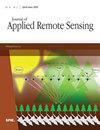CDCTA:级联双约束变压器自动编码器,用于具有内元变异性和光谱几何特征的高光谱非混合处理
IF 1.4
4区 地球科学
Q4 ENVIRONMENTAL SCIENCES
引用次数: 0
摘要
在高光谱图像(HSI)处理过程中,高光谱解混合(HU)是一个关键步骤。然而,由于自然场景中内含物的可变性和高光谱图像结构的复杂性,解混合方法的准确性受到了限制。内元变异性是指在高光谱遥感场景中,不同位置或不同条件下的内元所表现出的变化或差异。因此,要提高解混合结果的准确性,必须充分利用高光谱图像中的光谱、几何和空间信息,全面探索内元的光谱特征。我们提出了一种级联双约束变压器自动编码器(AE),适用于具有内含物变异性和光谱几何特征的 HU。该模型利用变压器自动编码器网络提取 HSI 中的全局空间特征。此外,它还结合了最小距离约束,以考虑 HSI 的几何信息。考虑到每种材料的内含物在形状上的相似性,而主要的内含物变化是通过整体强度波动表现出来的,因此提出了内含物光谱角距离的丰度加权约束方法。在训练过程中,该架构利用两个级联网络来保留恒星仪的详细信息。我们使用三个真实数据集对所提出的模型进行了评估。实验结果表明,所提出的方法在丰度估计和内元提取方面取得了优异的性能。此外,我们还通过消融实验验证了两种约束方法的有效性。本文章由计算机程序翻译,如有差异,请以英文原文为准。
CDCTA: cascaded dual-constrained transformer autoencoder for hyperspectral unmixing with endmember variability and spectral geometry
Hyperspectral unmixing (HU) in hyperspectral image (HSI) processing is a crucial step. However, the accuracy of unmixing methods is limited by the variability in endmember and the complexity of the HSI structure found in natural scenes. Endmember variability refers to the variations or differences exhibited by endmembers in different locations or under varying conditions within a hyperspectral remote sensing scene. Therefore, to enhance the accuracy of unmixing results, it is crucial to fully leverage spectral, geometric, and spatial information within HSIs, comprehensively exploring the spectral characteristics of endmembers. We present a cascaded dual-constrained transformer autoencoder (AE) for HU with endmember variability and spectral geometry. The model utilizes a transformer AE network to extract the global spatial features in the HSI. Additionally, it incorporates the minimum distance constraint to account for the geometric information of the HSI. Given the similarity in shape exhibited by endmembers of each individual material, with the primary endmember variability being expressed through overall intensity fluctuations, an abundance-weighted constraint method for endmember spectral angle distance is proposed. During training, the architecture utilizes two cascaded networks to preserve the detailed information in the HSI. We evaluate the proposed model using three real datasets. The experimental results indicate that the proposed method achieves superior performance in abundance estimation and endmember extraction. Furthermore, the effectiveness of the two constraint methods was verified through ablation experiments.
求助全文
通过发布文献求助,成功后即可免费获取论文全文。
去求助
来源期刊

Journal of Applied Remote Sensing
环境科学-成像科学与照相技术
CiteScore
3.40
自引率
11.80%
发文量
194
审稿时长
3 months
期刊介绍:
The Journal of Applied Remote Sensing is a peer-reviewed journal that optimizes the communication of concepts, information, and progress among the remote sensing community.
 求助内容:
求助内容: 应助结果提醒方式:
应助结果提醒方式:


